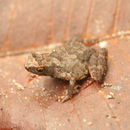Description
provided by AmphibiaWeb articles
Males 14-17 mm, females 18-23 mm. The body is thin, except for gravid females. The dorsum has an irregular pattern formed by patches of different shades of brown. Very close examination may reveal tiny green dots among the brown. The fore part of the ventral surface is black, and the hind part of the belly is white with black dots. The hind legs are longer than the body.Juvenile Bufo proboscideus are similar in general form, but the hind legs are longer than the body in A. minuta, and shorter than the body in B. proboscideus. The ventral surface is gray to brown in B. proboscideus.A note on its taxonomy:When Fouquet used Amazonella in 2012, he was unaware of its original description in 1931 of an Amazonian water mite, thus making it a junior homonym of Amazonella Lundquist 1931. Fouquet et al (2012) therefore proposed Amazophrynella nom. nov. as a replacement name, derived from the words Amazonia (its regional distribution), phryne (meaning toad in Greek) and the feminine diminutive suffix "-ella" referring to its small size (Fouquet et al. 2012).
Fouquet, A., Recoder, R., Teixeira, M., Cassimiro, J., Amaro, R.C., Camacho, A. Damasceno, R., Carnaval, A.C., Moritz, C., Rodrigues, M.T. (2012). ''Amazonella Fouquet et al., 2012 (Anura:Bufonidae) junior homonym of Amazonella Lundblad, 1931 (Acari:Unionicolidae): proposed replacement by Amazophrynella nom. nov. CORRESPONDENCE.'' Zootaxa, 3244, 68.
- author
- Albertina P. Lima
- author
- William E. Magnusson
- author
- Marcelo Menin
- author
- Luciana K. Erdtmann
- author
- Domingos J. Rodrigues
- author
- Claudia Keller
- author
- Walter Hödl
Distribution and Habitat
provided by AmphibiaWeb articles
The species is frequently found throughout the Reserva Florestal Adolpho Ducke in Brazil, but is more common in the low-lying areas around streams in the eastern half.
- author
- Albertina P. Lima
- author
- William E. Magnusson
- author
- Marcelo Menin
- author
- Luciana K. Erdtmann
- author
- Domingos J. Rodrigues
- author
- Claudia Keller
- author
- Walter Hödl
Life History, Abundance, Activity, and Special Behaviors
provided by AmphibiaWeb articles
The species is terrestrial and diurnal, and normally encountered in low-lying areas near streams. The diet consists principally of ants, beetles, mites and collembolans. Reproduction occurs in the wet season from November to May. Females lay about 70-250 pigmented eggs during the day or night. Clutches are deposited on roots, tree trunks or fallen leaves near shallow ponds that are formed principally by rain water. Tadpoles, which are small (maximum length about 18 mm), with cream bodies and transparent fins, can be found in small (generally 20-50 cm2) pools beside larger pools
- author
- Albertina P. Lima
- author
- William E. Magnusson
- author
- Marcelo Menin
- author
- Luciana K. Erdtmann
- author
- Domingos J. Rodrigues
- author
- Claudia Keller
- author
- Walter Hödl

